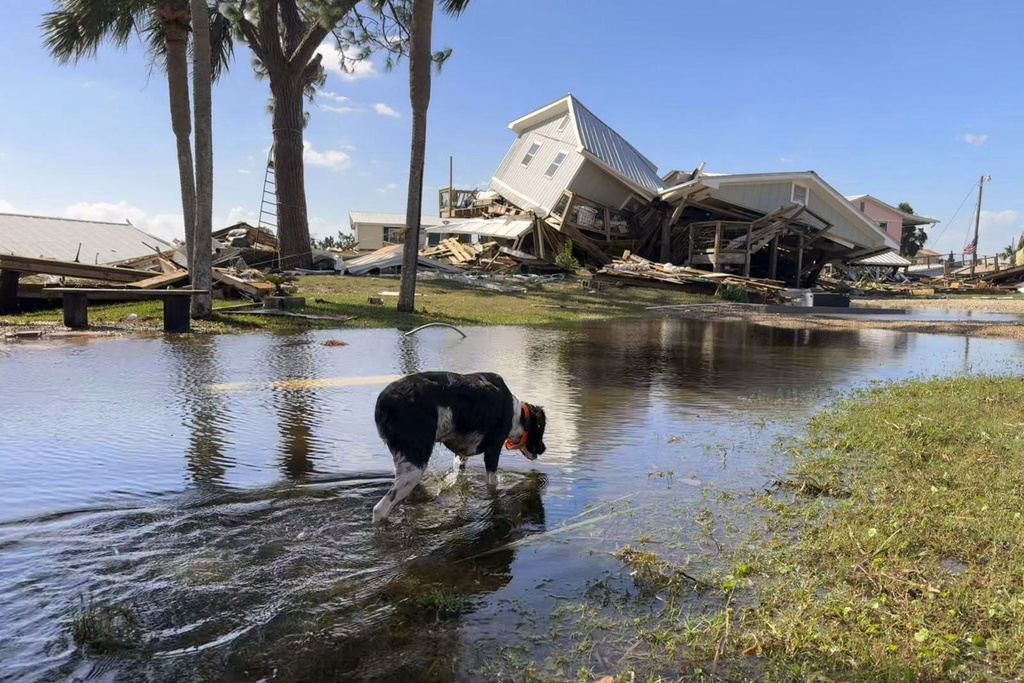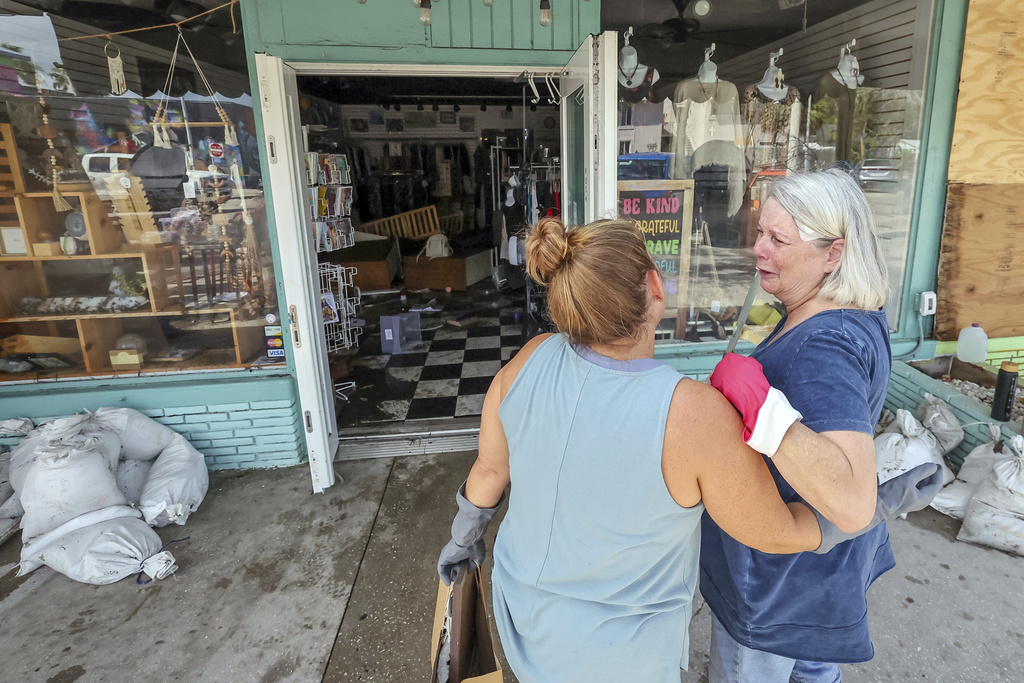Hurricane Helene Wreaks Havoc Across Florida, Killing 44 \ Newslooks \ Washington DC \ Mary Sidiqi \ Evening Edition \ Hurricane Helene tore through Florida and the southeastern U.S., killing at least 44 people and causing widespread devastation. The storm’s powerful winds uprooted trees, destroyed homes, and triggered dangerous floods, leaving millions without power. President Biden deployed FEMA resources, and rescuers conducted hundreds of rescues amid ongoing damage.

Hurricane Helene’s Impact: Quick Looks
- Hurricane Helene devastated the southeastern U.S., killing 44 people, including three firefighters and a mother with twin infants.
- The Category 4 storm hit Florida’s Big Bend with 140 mph winds.
- Moody’s Analytics estimates property damage between $15 billion and $26 billion.
- Helicopter rescue at Unicoi County Hospital in Tennessee evacuated 54 people safely.
- Flooding led to record rainfall in Atlanta and significant damage in several states.
- Tornadoes, dam overflows, and mudslides affected multiple areas, leading to widespread evacuations.
- President Biden deployed FEMA workers, helping with over 400 rescues.
- Power outages impacted over 3 million homes across multiple states.
Deep Look:
Hurricane Helene unleashed a massive path of devastation across Florida and the southeastern United States on Friday, leaving at least 44 people dead, damaging critical infrastructure, and prompting extensive rescue efforts. The storm, classified as a powerful Category 4 hurricane at landfall, struck Florida’s rural Big Bend area late Thursday with maximum sustained winds of 140 mph (225 kph). The destruction spanned from Florida up through Georgia, the Carolinas, and even reached parts of Virginia and Tennessee.
The hurricane left an indelible mark, snapping towering oak trees, tearing homes apart, and leaving entire neighborhoods underwater. Among those who lost their lives were three firefighters, a mother and her 1-month-old twins, and an 89-year-old woman who was killed when a tree fell on her house. According to an Associated Press tally, fatalities were reported in Florida, Georgia, North Carolina, South Carolina, and Virginia.
The impact of Hurricane Helene was widespread and severe, with damage estimates ranging from $15 billion to $26 billion, according to Moody’s Analytics. The hurricane brought with it an overwhelming storm surge and heavy rainfall that led to record-breaking flooding, particularly in Georgia and Tennessee. One of the most harrowing incidents occurred at the Unicoi County Hospital in northeast Tennessee, where rapidly rising floodwaters forced 54 people to evacuate to the hospital’s roof. Rescue helicopters successfully evacuated everyone from the flooded facility, according to Ballad Health.
The storm first made landfall in Florida’s sparsely populated Big Bend area, a region known for its fishing communities and vacation spots. Florida Governor Ron DeSantis noted that the damage from Hurricane Helene appears to surpass the combined effects of Hurricane Idalia and Hurricane Debby, which both struck the region in recent years. DeSantis, speaking from a storm-damaged area in St. Pete Beach, acknowledged the severity of the destruction but emphasized Florida’s resilience. “It’s tough, and we understand that. We also understand that this is a resilient state,” he said during a press conference.
The hurricane’s reach extended far beyond Florida. In Georgia, more than 100 high-voltage transmission lines were damaged, leading to widespread power outages. The Georgia Office of the State Climatologist reported that Atlanta received a record 11.12 inches (28.24 centimeters) of rain in just 48 hours—the most the city has seen in such a period since record-keeping began in 1878. Some neighborhoods in Atlanta were so severely flooded that only car roofs were visible above the waterline. The previous rainfall record of 9.59 inches (24.36 cm) was set in 1886, highlighting the unprecedented nature of Helene’s impact.
North Carolina experienced extensive flooding as well, including the overtopping of a dam at Lake Lure, a body of water famous for its appearance in the film “Dirty Dancing.” Though the dam did not immediately fail, surrounding neighborhoods were evacuated as a precaution. In another part of North Carolina, a tornado touched down in Nash County, critically injuring four people. Statewide, over 300 roads were closed due to floodwaters and damage, and evacuation orders were issued in numerous communities.
President Joe Biden announced that he was praying for the victims and survivors, and the Federal Emergency Management Agency (FEMA) mobilized more than 1,500 personnel to aid in rescue and recovery efforts. By Friday morning, FEMA workers had assisted in over 400 rescues. The agency’s head also traveled to the affected areas to oversee the ongoing operations. In Tampa, Florida, entire areas were accessible only by boat due to the floodwaters, and officials repeatedly urged residents not to wade into the water due to hidden dangers such as live electrical wires, sewage, sharp debris, and other hazards.
The storm also brought significant tragedy to the Pinellas County area of Florida, where all five victims in one neighborhood had been told to evacuate. Despite the evacuation order, many chose to stay, with some ultimately seeking refuge in their attics as floodwaters rose. Sheriff Bob Gualtieri of Pinellas County said that emergency crews were conducting door-to-door searches in flooded areas, and he warned that the death toll could rise as more victims are discovered.
The damage wasn’t limited to private homes; public infrastructure also suffered significantly. In the southern parts of Georgia, several hospitals lost power as the storm knocked down trees and power lines. Governor Brian Kemp noted that state authorities had to use chainsaws to clear roads, allowing emergency services to reach people in need. In South Carolina, over 40% of electricity customers experienced outages, and officials described crews having to cut through fallen debris just to assess the condition of the remaining infrastructure.
A mudslide in the Appalachian Mountains added to the chaos, washing out part of an interstate highway at the North Carolina-Tennessee state line. In Buncombe County, North Carolina, another mudslide hit several homes, with occupants forced to wait more than four hours before being rescued. Ryan Cole, the emergency services assistant director for Buncombe County, reported that the county’s 911 center received more than 3,300 emergency calls in just an eight-hour window on Friday, illustrating the overwhelming scale of the disaster.
In addition to the immediate physical destruction, the storm’s psychological impact on residents was profound. Laurie Lilliott, a resident of Dekle Beach, Florida, described returning to find her home completely destroyed, with only one corner propped up by a piling. She described the visceral fear she felt as she surveyed the wreckage, still bearing her name and phone number inked in permanent marker on her arm—a precaution taken to help identify bodies in the aftermath of the storm. The community has been hit by three hurricanes since August 2023, and Lilliott’s story is just one of many reflecting the toll of repeated disasters on Florida’s coastal communities.
The catastrophic flooding extended north, affecting as far as Ohio and Indiana due to Helene’s rapid movement. As of late Friday, more than three million homes and businesses were without power across the southeastern United States. In addition, emergency measures were put in place across multiple states, including curfews and mandatory evacuation orders to ensure public safety.
Beyond the U.S., Helene also impacted parts of Mexico and Cuba. On Mexico’s Yucatan Peninsula, the storm brought heavy rain and flooding to the resort city of Cancun, while western Cuba faced power outages affecting over 200,000 homes and businesses.
Hurricane Helene’s arrival is the latest reminder of the increasing frequency and severity of storms attributed to climate change. The warming ocean temperatures have created conditions that allow hurricanes to intensify more rapidly, transforming into dangerous cyclones within a short period. The National Oceanic and Atmospheric Administration (NOAA) has predicted an above-average hurricane season this year, citing record-warm waters as a significant factor.
Helene, the eighth named storm of the Atlantic hurricane season, demonstrated just how destructive these weather events can be, even when communities prepare as best they can. While Helene weakened after making landfall, transitioning into a post-tropical cyclone, its impact continued to bring catastrophic flooding and damage to areas already reeling from its initial force.
The recovery process is expected to take weeks, if not months, as communities across the southeastern United States begin to clean up and rebuild in the wake of Hurricane Helene. From Georgia to the Carolinas, thousands of residents remain displaced, facing power outages, structural damage, and the long road of rebuilding lives upended by the storm. As emergency services continue their efforts and the federal government assesses additional support, the storm serves as a sobering reminder of the vulnerabilities faced by coastal and inland communities alike in an era of increasingly volatile climate conditions.
Hurricane Helene Wreaks Hurricane Helene Wreaks Hurricane Helene Wreaks Hurricane Helene Wreaks







